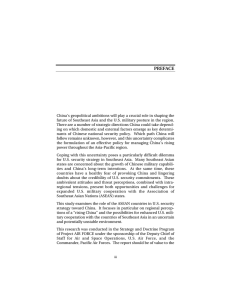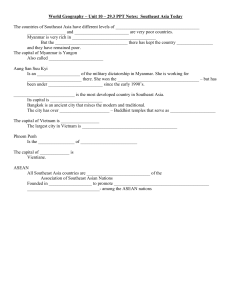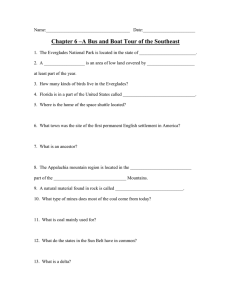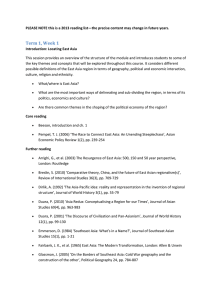SE Asia_B_e
advertisement
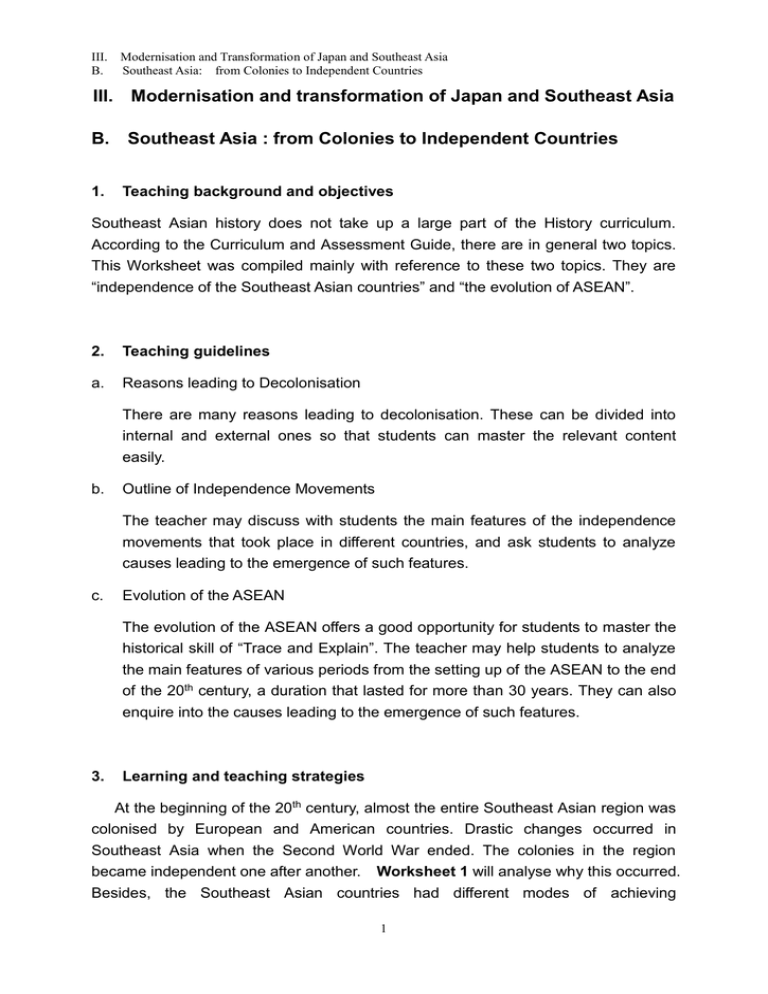
III. B. Modernisation and Transformation of Japan and Southeast Asia Southeast Asia: from Colonies to Independent Countries III. Modernisation and transformation of Japan and Southeast Asia B. 1. Southeast Asia : from Colonies to Independent Countries Teaching background and objectives Southeast Asian history does not take up a large part of the History curriculum. According to the Curriculum and Assessment Guide, there are in general two topics. This Worksheet was compiled mainly with reference to these two topics. They are “independence of the Southeast Asian countries” and “the evolution of ASEAN”. 2. Teaching guidelines a. Reasons leading to Decolonisation There are many reasons leading to decolonisation. These can be divided into internal and external ones so that students can master the relevant content easily. b. Outline of Independence Movements The teacher may discuss with students the main features of the independence movements that took place in different countries, and ask students to analyze causes leading to the emergence of such features. c. Evolution of the ASEAN The evolution of the ASEAN offers a good opportunity for students to master the historical skill of “Trace and Explain”. The teacher may help students to analyze the main features of various periods from the setting up of the ASEAN to the end of the 20th century, a duration that lasted for more than 30 years. They can also enquire into the causes leading to the emergence of such features. 3. Learning and teaching strategies At the beginning of the 20th century, almost the entire Southeast Asian region was colonised by European and American countries. Drastic changes occurred in Southeast Asia when the Second World War ended. The colonies in the region became independent one after another. Worksheet 1 will analyse why this occurred. Besides, the Southeast Asian countries had different modes of achieving 1 III. B. Modernisation and Transformation of Japan and Southeast Asia Southeast Asia: from Colonies to Independent Countries independence, with some countries experiencing a smooth process, while some having to go through wars. We will study such modes in Worksheet 2. Lastly, after acquiring independence, relationships among the Southeast Asian countries were not cordial, and there were even territorial disputes among them. However, these countries understood that disputes would only bring about instability to the Southeast Asian region and hinder its economic development, thus harming the international status of various countries of Southeast Asia as a whole. In 1967, the Southeast Asian countries finally set aside their prejudices and set up the ASEAN for the sake of regional co-operation. These developments will be discussed in Worksheet 3. 4. Expected outcomes / Reflections Students should not encounter too many problems in the study of the history of Southeast Asia, as not too many complicated issues are involved. 2 III. B. Modernisation and Transformation of Japan and Southeast Asia Southeast Asia: from Colonies to Independent Countries Worksheet 1 Internal and External Factors for Decolonisation What is meant by decolonisation ? American and European colonies in Asia and Africa used various means to free themselves from the control of their sovereign states and struggle for independence. This process was known as decolonization. Factors within the Southeast Asian Region (Internal Factors) Revival of Traditional Cultures and Religions Although the culture of the Southeast Asian region does not have a history as long as that of the Chinese culture, it is not as short as that of the USA, which has a short history of about 200 years. Therefore, although Southeast Asia was conquered by the Western countries, the civilization of that region still had strong vitality. Once opportunity presented itself, the people of Southeast Asia would overthrow the colonial rule. Evidence for the long history of culture of Southeast Asia: The most important ancient civilization of Southeast Asia is Khmer culture (hint: located in Cambodia). Its most famous historic site is Angkor Wat. Besides, of the three major religions in the world, Buddhism and Islam exist in Southeast Asia for a long time, which have preserved a lot of cultural heritage of Southeast Asia, enabling their followers in the Southeast Asian region to have a sense of pride for the history of their own ethnic group. Buddhism was popular in: Thailand and Burma Islam was popular in: Indonesia 3 III. B. Modernisation and Transformation of Japan and Southeast Asia Southeast Asia: from Colonies to Independent Countries Influences of Western Colonial Rule Negative Influence Western colonial rule left a negative image to the people of Southeast Asia, thus arousing their determination to overthrow colonial rule. Below are some important examples: The Western powers plundered the local resources, e.g.: Western countries tapped the natural resources extensively in different places of Southeast Asia. The Western powers laboured the local people, e.g.: Forcing the local people to carry out construction of large-scale public infrastructure. The Western powers deprived the local people of economic freedom, e.g.: Forcing the local people to farm and to pay tax in terms of cash crops. The Western powers discriminated against the local people, violating the principle of equality, e.g.: White people of the West and Southeast Asian had the same job but different pay. Positive Influence The Western powers implemented Western education in Southeast Asia, thus enhancing the literacy of the local people. This is also a cause of decolonisation. What is the causal relationship between the two? The Southeast Asian peoples studied Western ideas such as liberty, equality and nationalism etc. However colonialism was against these principles, thus the Southeast Asian people struggled against colonial rule to realize their ideals. Western colonial rule improved transport systems and gradually modernized the colonies. This is another benefit, which also resulted in decolonization. How can this causal relationship be explained? These infrastructures enabled the spread of these ideas of liberty, equality and nationalism in 4 III. B. Modernisation and Transformation of Japan and Southeast Asia Southeast Asia: from Colonies to Independent Countries Southeast Asia and allowed more local people coming into contact of these ideas, thus strengthened the power of anti-colonial rule. Factors other than the Southeast Asian region (External Factors) Influences from China In 1911, revolution broke out in China. The Han people overthrew the Manchu regime and restored the Han people’s rule of China. How did this inspire the Southeast Asian peoples? Southeast Asian peoples imitated Sun Yixian to carry out revolution to overthrow colonial rule of the western powers (foreigners). Influence from Japan The Meiji Reform in Japan succeeded, and the unequal treaties that foreigners imposed on the Japanese people were repealed. How did this inspire the Southeast Asian peoples? The success of Meiji Modernisation proved that if the Southeast Asian peoples could make up their mind to strengthen their nations, they would ultimately get rid of the colonial rule of the western powers, as the Japanese had done. Influence from Europe The First World War ended in 1918, and the Paris Peace Conference was held the next year. The American president Woodrow Wilson put forward the principle of “National self-determination”, with the view that national minority groups should be able to set up their own country. How did this encourage the Southeast Asian peoples? In those days, the Southeast Asian peoples were under foreign rule. The American principle of “national self-determination” was used as a strong legal basis for the Southeast Asians to get rid of western colonial rule. Influence brought about by the Second World War In 1941, Japan declared war on Britain and the USA. It attacked Southeast Asia, with the slogan “Asia for the Asian peoples”. It openly declared that it would set up the Greater East Asia Co-Prosperity Sphere. How did this attract the Southeast Asian peoples? 5 III. B. Modernisation and Transformation of Japan and Southeast Asia Southeast Asia: from Colonies to Independent Countries Southeast Asia is part of Asia and belongs to the peoples of Southeast Asia, the Western powers had no sound reasons to continue their rule over those people. The Japanese slogan reflects aptly the voice of the Southeast Asian peoples. (Note: Very soon, the real side of the Japanese militarists was revealed by Japanese aggressions. The people of Southeast Asia were forced to labour and were cheated. So they supported countries like Britain and the USA to fight against Japan.) When the Second World War ended, colonial powers such as Britain and France were greatly weakened. What opportunity did this offer to the peoples of Southeast Asia? The military strengths of the European powers had been seriously weakened. The powers became unable to resist the revolts of the Southeast Asian peoples. The time was ripe for overthrowing colonial rule. Conclusion: The factors mentioned above encouraged people of all ethnic groups in Southeast Asia to launch independence movements after the Second World War, and they eventually succeeded. 6 III. B. Modernisation and Transformation of Japan and Southeast Asia Southeast Asia: from Colonies to Independent Countries Worksheet 2 General Situation of Independence Movements The process of becoming independent for the Southeast Asian countries could be divided into three types according how peaceful they were: the most peaceful, peaceful and non-peaceful. The most peaceful mode: support from the suzerain state Method: The suzerain state was aware of the fact that colonial rule violated the spirit of liberty and equality, and was willing to guide the people of its colony to set up a democratic system, and was willing to let its colony become independent when the time is right. Example: Suzerain State: the U.S.A. Colony: The Philippines Process of achieving independence Step 1: Educating the people of the Philippines Actual situation: Carried out educational reforms and made great investment in the development of education. Step 2: Setting up a democratic system in the Philippines Actual situation: Set up an elected parliament which consisted of upper and lower houses. Step 3: Training of political talents Actual situation: Expanding the number of parliament members in order to give more Filipinos chances to take part in politics. Step 4: Declaring the independence of the Philippines In 1946, the U.S.A. allowed the independence of the Philippines. 7 III. B. Modernisation and Transformation of Japan and Southeast Asia Southeast Asia: from Colonies to Independent Countries Peaceful Mode: Consultation on Autonomy Mode: Originally, the suzerain state was not willing to grant its colony independence. However, under the pressure of the situations, it had to grant its colony autonomy in order to buy time, and it granted them independence when situation became entirely hopeless. Example 1: Suzerain State: Britain Colony: Burma Process of Achieving Independence Step 1: The First World War weakened Britain’s national strength. Under the pressure of the situations, it had to revise its mode of administering Burma. Actual situation: Britain allowed Burma to take charge of its domestic affairs. (Except national defense and diplomacy .) Step 2: Allowing Burma to become an independent administration unit, enhancing its autonomy. Actual situation: Britain separated Burma from the British jurisdiction of India and made it an independent administrative region . Step 3: After the Second World War, Britain was further weakened. India declared independence. It was very difficult for Britain to rule Burma (situation became entirely hopeless), and it had to make concessions. Actual situation: In 1948, Britain gave its consent to Burma’s separation from Britain and independence. Example 2: Suzerain State: Britain Colony: Malaya (1957 - 1963) / Malaysia (1963 - now) 8 III. B. Modernisation and Transformation of Japan and Southeast Asia Southeast Asia: from Colonies to Independent Countries Process of Achieving Independence Step 1: After the Second World War, India and Burma became independent one after the other. Independence movements spread to Malaya. In order to pacify the Malayan people, the British government made concessions. Actual situation: Britain carried out administrative reforms and democratic election in Malaya so that the Malay could learn self-rule. Step 2: The Malayan were not satisfied with achieving autonomy. They further pressured Britain, which finally gave up Malaya unwillingly. Actual situation: Britain agreed to the independence of Malaya in 1957. Step 3: The voice of call for independence spread to the regions of Sabah, Sarawak and Singapore. Britain once again made concessions, and allowed these regions to get away from British administration. Actual situation: Malaya, Singapore, Sabah and Sarawak and Sarah formed the Federation of Malaysia. Step 4: Independence of Singapore Actual situation: In 1965, Singapore separated from Malaysia and became an independent country. Non-peaceful Mode: Armed Struggle Mode: The suzerain state refused to give in, and stayed in confrontation with the people of its colony. Wars broke out. The suzerain state was defeated eventually, and was overthrown by the people of the colony. Example 1: Suzerain State: France Colony: North Vietnam 9 III. B. Modernisation and Transformation of Japan and Southeast Asia Southeast Asia: from Colonies to Independent Countries Step 1: During the Second World War, Japan attacked the French Indochina and expelled French power. Ho Chi Minh, a Vietnamese, formed an armed organization to fight against the Japanese. Actual situation: Ho Chi Minh set up the League for the Independence of Vietnam, known as the Viet Minh, and led the anti-Japanese struggles Step 2: After the Second World War, France regained Indochina. Ho Chi Minh formed another government to fight against the French. Actual situation: In 1945, Viet Minh announced independence of its nation and set up the Democratic Republic of Vietnam. Step 3: The French were defeated and withdrew from Indochina. Vietnam became independent, but the country was divided into two parts. Actual situation: After defeating the French in the Battle of Dien Bien Puh in 1954, Vietnam achieved independence in the Geneva Conference, but it was divided into North Vietnam and South Vietnam by the demarcation line along the 17th parallel of latitude. Example 2: Suzerain State: Netherlands Colony: Indonesia Step 1: During the Second World War, Japan attacked the Dutch East Indies and expelled Dutch influence from the region. Step 2: 10 III. B. Modernisation and Transformation of Japan and Southeast Asia Southeast Asia: from Colonies to Independent Countries After the Second World War, Dutch influence returned to the East Indies, but it encountered resistance from the local people. Actual situation: As the Dutch government was unwilling to give up Indonesia, it fought with the local opposition party for a long period of time. Step 3: During the period 1945-49, war broke out in the East Indies. The United Nations intervened and resolved the conflicts. Actual situation: With the intervention of the United Nations which put pressure on Netherlands, Indonesia finally got independence in 1949. 11 III. B. Modernisation and Transformation of Japan and Southeast Asia Southeast Asia: from Colonies to Independent Countries Worksheet 3 Regional Co-operation ─ Development of Association of Southeast Asian Nations (ASEAN) The Setting up of the Association of Southeast Asian Nations (ASEAN) By the 1960s, most of the countries in the Southeast Asian region had achieved independence. However, relationships among them were not harmonious, and disputes over territorial sovereignty often occurred. Below are two main examples: 1. Dispute over territorial sovereignty of Sarawak: Countries in dispute: Malaysia and Indonesia 2. Dispute over territorial sovereignty of Sabah: Countries in dispute: Malaysia and the Philipines However, along with the development of international situation, the Southeast Asian countries gradually realized that disputes among themselves would not be a good thing to Southeast Asia as a whole. They began to consider trying regional co-operation. Below are the main reasons for such a change. Experiences of Regional Co-operation before Setting up of ASEAN Even before the setting up of ASEAN (1967), the Southeast Asian countries had already had limited regional co-operation among themselves. Despite limited effectiveness, such experience was helpful to the setting up of ASEAN later. Examples of such earlier co-operations include: 1. Southeast Asia Treaty Organization (SEATO) (1955) This organization was similar to the North Atlantic Treaty Organization (NATO) among the European countries and the USA. The member states formed an alliance to prevent the spread of communism in Southeast Asia. Although its name specifies “Southeast Asia”, of the eight members states only two were Southeast Asian countries, which were Thailand 12 III. B. Modernisation and Transformation of Japan and Southeast Asia Southeast Asia: from Colonies to Independent Countries and the Philippines 2. As mentioned above, there were territorial disputes between Malaysia and the Philippines, and between Malaysia and Indonesia. However, some international organizations were set up between them. This shows their ambivalence of being hostile to and yet felt the need to co-operate with each other. The organization formed by Malaysia and the Philippines was: Association of Southeast Asia (including Thailand) The organization formed by Malaysia, the Philippines and Indonesia was: Greater Malay Confederation Threat of Communism In the 1960s, the communist North Vietnam was becoming stronger and stronger, while most of the Southeast Asian countries were supporters of capitalism. The growing in power of North Vietnam resulted in the following impact on the Southeast Asian countries: The Southeast Asian countries should bury the hatchet and be united against the Vietnamese threat. Trend of Economic Co-operation Beginning from the 1950, economic co-operation in Europe developed rapidly and made a number of achievements. The Southeast Asian countries were at a stage of economic development. In what ways were they inspired by the economic co-operation among Western European countries? The European countries had all sorts of economic cooperation with fruitful achievements. They became a good example for the Southeast Asian countries to follow. Result: In 1967, the Association of Southeast Asian Nations was formally set up. Its founding members include: Indonesia, Thailand, the Philippines and Malaysia Due to the smooth development of ASEAN, other co-operative organizations in Southeast Asia gradually disappeared. 13 III. B. Modernisation and Transformation of Japan and Southeast Asia Southeast Asia: from Colonies to Independent Countries Evolution of ASEAN First Stage: 1967-1975 Characteristics: Non-active period Causes: Member states had territorial disputes and diplomatic differences, e.g. China became Indonesia’s imaginery enemy while North Vietnam was the major enemy of other Southeast Asian countries. Evaluation: Failed to achieve objectives, for example: Could not reach the target, did not carry out technology and cultural exchanges, nor carry out effective policies to promote the economic growth of the Southeast Asian region. Second Stage: 1975-1980 Characteristics: strengthened the sense of cooperation Causes: Vietnam won the Vietnamese War; Cambodia and Laos set up Communist regimes; the Communist threat was strengthened ; the Southeast Asian countries must accelerate their pace for cooperation to resist these threats. Evaluation: Strengthening of Economic Co-operation, for examples: Started many regional economic cooperation programme, giving mutual preferential tariff and explored joint industrial ventures. Strengthening of Military Co-operation, for examples: Member states had joint military rehearsals and exchanged military intelligence. 14 III. B. Modernisation and Transformation of Japan and Southeast Asia Southeast Asia: from Colonies to Independent Countries Third Stage: After 1980 Characteristics: Established close collaboration and the number of member states increased. Causes: Vietnam wished to improve relationship with other Southeast Asian countries and withdrew from Cambodia. Expansion of ASEAN - evaluation: Increase of number of member states: Vietnam, Laos, Burma and Cambodia Situation in 1999 was: Strengthening of Economic Co-operation In 1991, ASEAN set up the ASEAN Free Trade Area to promote regional free trade. Achievements and Limitations of ASEAN Achievements: Maintaining Regional Peace Stopping War, for example: Put pressure on Vietnam, forcing her to stop invading Cambodia. Territorial Disputes, for example: Appealed to the member states to have self-control and use calm and peaceful means to solve territorial disputes. Enhancing the international status of the Southeast Asian region Other regions were willing to strengthen their economic co-operation with ASEAN, e.g.: The ASEAN and the European Union , the U.S.A., Japan etc. held conferences to discuss economic and trading affairs. 15 III. B. Modernisation and Transformation of Japan and Southeast Asia Southeast Asia: from Colonies to Independent Countries Limitations: Limited economic development, for example: The major concern of the member states of the ASEAN was about their own economic development. They did not care much about joint ventures which were not beneficial to their national economies. Therefore, although there was growth in the Southeast Asian economy, it was limited. Conclusion The old-time saying that “Unity is Strength” has been demonstrated once again by the history of the development of the Southeast Asian countries. Before the Second World War, Southeast Asia had been the colonies of Western countries for a long time. Credit should be given to the collective efforts and common development of the ASEAN countries for the fact that they were able to establish reciprocal relationships with the European and American powers in the several decades of independence after WWII. 16
